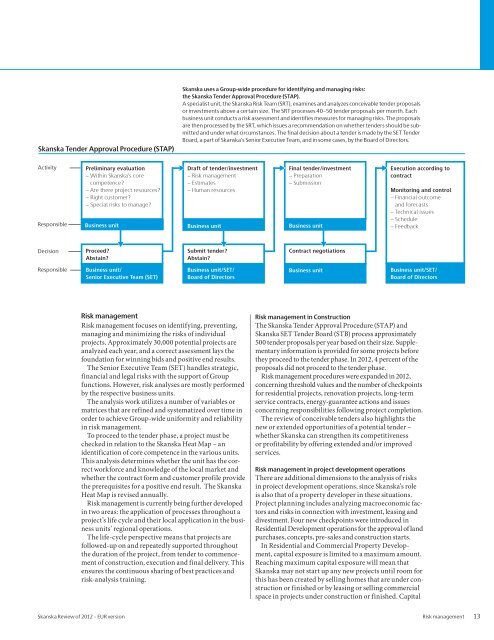Review of 2012 â EUR - Skanska
Review of 2012 â EUR - Skanska
Review of 2012 â EUR - Skanska
Create successful ePaper yourself
Turn your PDF publications into a flip-book with our unique Google optimized e-Paper software.
<strong>Skanska</strong> Tender Approval Procedure (STAP)<strong>Skanska</strong> uses a Group-wide procedure for identifying and managing risks:the <strong>Skanska</strong> Tender Approval Procedure (STAP).A specialist unit, the <strong>Skanska</strong> Risk Team (SRT), examines and analyzes conceivable tender proposalsor investments above a certain size. The SRT processes 40–50 tender proposals per month. Eachbusiness unit conducts a risk assessment and identifies measures for managing risks. The proposalsare then processed by the SRT, which issues a recommendation on whether tenders should be submittedand under what circumstances. The final decision about a tender is made by the SET TenderBoard, a part <strong>of</strong> <strong>Skanska</strong>’s Senior Executive Team, and in some cases, by the Board <strong>of</strong> Directors.ActivityResponsiblePreliminary evaluation– Within <strong>Skanska</strong>’s corecompetence?– Are there project resources?– Right customer?– Special risks to manage?Business unit◀Draft <strong>of</strong> tender/investment– Risk management– Estimates– Human resourcesBusiness unit◀Final tender/investment– Preparation– SubmissionBusiness unit◀Execution according tocontractMonitoring and control– Financial outcomeand forecasts– Technical issues– Schedule– FeedbackDecisionProceed?Abstain?◀◀Submit tender?Abstain?◀Contract negotiationsResponsibleBusiness unit/Senior Executive Team (SET)Business unit/SET/Board <strong>of</strong> DirectorsBusiness unitBusiness unit/SET/Board <strong>of</strong> DirectorsRisk managementRisk management focuses on identifying, preventing,managing and minimizing the risks <strong>of</strong> individualprojects. Approximately 30,000 potential projects areanalyzed each year, and a correct assessment lays thefoundation for winning bids and positive end results.The Senior Executive Team (SET) handles strategic,financial and legal risks with the support <strong>of</strong> Groupfunctions. However, risk analyses are mostly performedby the respective business units.The analysis work utilizes a number <strong>of</strong> variables ormatrices that are refined and systematized over time inorder to achieve Group-wide uniformity and reliabilityin risk management.To proceed to the tender phase, a project must bechecked in relation to the <strong>Skanska</strong> Heat Map – anidentification <strong>of</strong> core competence in the various units.This analysis determines whether the unit has the correctworkforce and knowledge <strong>of</strong> the local market andwhether the contract form and customer pr<strong>of</strong>ile providethe prerequisites for a positive end result. The <strong>Skanska</strong>Heat Map is revised annually.Risk management is currently being further developedin two areas: the application <strong>of</strong> processes throughout aproject’s life cycle and their local application in the businessunits’ regional operations.The life-cycle perspective means that projects arefollowed-up on and repeatedly supported throughoutthe duration <strong>of</strong> the project, from tender to commencement<strong>of</strong> construction, execution and final delivery. Thisensures the continuous sharing <strong>of</strong> best practices andrisk-analysis training.Risk management in ConstructionThe <strong>Skanska</strong> Tender Approval Procedure (STAP) and<strong>Skanska</strong> SET Tender Board (STB) process approximately500 tender proposals per year based on their size. Supplementaryinformation is provided for some projects beforethey proceed to the tender phase. In <strong>2012</strong>, 4 percent <strong>of</strong> theproposals did not proceed to the tender phase.Risk management procedures were expanded in <strong>2012</strong>,concerning threshold values and the number <strong>of</strong> checkpointsfor residential projects, renovation projects, long-termservice contracts, energy-guarantee actions and issuesconcerning responsibilities following project completion.The review <strong>of</strong> conceivable tenders also highlights thenew or extended opportunities <strong>of</strong> a potential tender –whether <strong>Skanska</strong> can strengthen its competitivenessor pr<strong>of</strong>itability by <strong>of</strong>fering extended and/or improvedservices.Risk management in project development operationsThere are additional dimensions to the analysis <strong>of</strong> risksin project development operations, since <strong>Skanska</strong>’s roleis also that <strong>of</strong> a property developer in these situations.Project planning includes analyzing macroeconomic factorsand risks in connection with investment, leasing anddivestment. Four new checkpoints were introduced inResidential Development operations for the approval <strong>of</strong> landpurchases, concepts, pre-sales and construction starts.In Residential and Commercial Property Development,capital exposure is limited to a maximum amount.Reaching maximum capital exposure will mean that<strong>Skanska</strong> may not start up any new projects until room forthis has been created by selling homes that are under constructionor finished or by leasing or selling commercialspace in projects under construction or finished. Capital<strong>Skanska</strong> <strong>Review</strong> <strong>of</strong> <strong>2012</strong> – <strong>EUR</strong> version Risk management 13
















